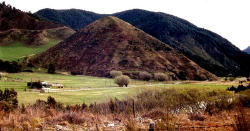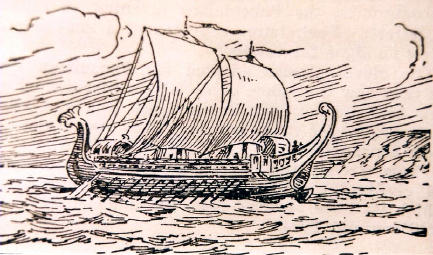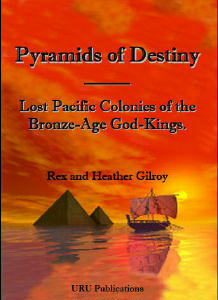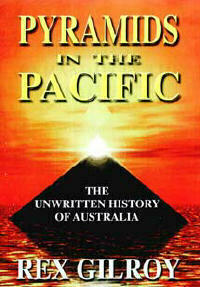
| Pyramids of Destiny – Lost Pacific Colonies of the Bronze-Age God-Kings |
 |
One of Queen Hatshepsut’s ocean-going vessels. In 1493 BC Egyptians made an expedition in ships such as this type to the Land of Punt.
This is described in the temple at Dehr al Bahri, from which this drawing is taken. Illustration from Conquest of Man – the saga of Early Exploration and Discovery, by Paul Herrmann, Hamish Hamilton, London 1954. |
Pyramids of Destiny – Lost Pacific Colonies of the Bronze-Age God-Kings
by Rex & Heather Gilroy
Copyright
© Rex Gilroy 2009
| “Australian history is almost always picturesque; indeed it is so curious and strange, that it is itself the chiefest novelty the country has to offer, and so it pushes all other novelties into second and third place. It does not read like history but like the most beautiful lies. Mark Twain: Following the Equator [1891] |
”Every truth passes through three stages before it is recognised. In the first, it is ridiculed. In the second, it is opposed. In the third, it is regarded as self evident.” Arthur Schopenhauer [1788-1860] |
Part Three.
Lost Egypto-Phoenician Colonies of Queensland’s Far North.
Chapter Fourteen.
1770 or 1770 BC? Egypto-Phoenician Colonists of Capricornia.
All removable rock inscriptions described in this chapter were removed for safekeeping and research by the authors.Roughly half way between Bundaberg and Rockhampton lies Bustard Bay, site of the little holiday town of 1770, and now the site of an ancient mining colony whose full extent has yet to be fully ascertained, but which flourished at the height of the Bronze-Age [2000-1400 BC].
Further south lies Maryborough and Hervey Bay, with Fraser Island offshore. This stretch of coastline is rich with links to Lieutenant James Cook RN, who in May 1770 sailed by Fraser Island’s Indian Head, naming it for the large number of Aborigines who had gathered on the hilltop curiously watching his passage along the coastline. He afterwards anchored in Bustard Bay before coming ashore at Round Hill Creek, near the site of the town of Seventeen Seventy.
Yet he was not the first mariner to set foot here, for the wide, deep inlet which flows 10km or so inland, provided a safe anchorage for mineral-seeking explorers from the land of the Nile who would leave their tell-tale rock inscriptions along its shores, for Rex and Heather Gilroy to discover over 3,000 years later!
It was during our July 2002 expedition to Far North Queensland that, having just investigated the Maryborough/Tin Can Bay/Gympie colony, we were driving north along the Bruce Highway. The day was Sunday 14th July when, as we approached the turnoff to Seventeen Seventy I received another of my famous “psychic messages” and requested Heather to drive us out there because I was ‘told’ that I would make a major discovery there.
Upon reaching the coast at Agnes Waters I felt that this area contained evidence of ancient colonisation, but a search hereabouts would have to wait as we were on limited time. Six kilometres further north lay Seventeen Seventy. Here we investigated the coastal bushland and harbourfront in search of rock inscriptions or any other signs of possible ancient settlement. It was not long before our efforts began bearing fruit.
Upon a densely scrub-covered hill I found, scattered on the leafmould strewn ground in the space of a few minutes, three stones, two being human face caricatures, the other bearing an inscription. One face carving had been engraved upon a 7.5cm thick roundish lump of granite 17.5cm tall by 16cm width and displayed two round eyes from each of which extended downwards a line joining to become a nose with a wide, narrow mouth engraved immediately beneath.
The second face carving had been engraved upon a slab of hard mudstone and was missing the top of the stone just above the two eyes, and more stone was missing below the chin. The fragment measured 14cm in height by 9.5cm in width and 5cm thick. The two eyes were round, there was the faded outline of where a long nose had been, and there was a wide, deep mouth engraved beneath.
The inscribed stone, a 6cm thick slab of mudstone measuring 15.5cm tall by 14.5cm in width, bore what appeared to be a locally-created Egypto-Phoenician script which was soon translated to read: “Ra the Royal Sun”. I suspected that the area from which these engraved stones had come had once been the site of an ancient temple.
With some difficulty I made a search of the hill, fighting my way through scratching shrubbery and vines to find the ground littered with granite rubble, this covering a considerable area and in a roughly square formation, facing the ocean near a clifftop.
From the meagre evidence gathered here I soon deduced that the two stone face carvings were “graffiti heads” and that they might have represented offerings made at the temple; the inscribed stone being a “votive offering” inscription once left there with an offering to the god.
Here I believed, once stood a temple dedicated to Ra, facing eastwards across the ocean where he rose each morning.
Main Book Index | Mysterious Australia Homepage | URU Homepage | Australian Yowie Research Centre

